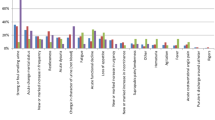Abstract
Objective
To determine the utility of urinalysis and dipstick results in predicting urinary tract infections in catheterized ICU patients.
Design and setting
Urine samples were collected for 4 months from patients admitted a ten-bed surgical ICU of an urban public teaching hospital designated by the state of New York as a level I trauma center. The correlation was analyzed between urinalysis and dipstick results from urine samples and subsequent quantitative culture results.
Patients
All patients with indwelling urinary catheters admitted to the ICU were considered eligible; 106 patients were enrolled, and 300 individual urine samples were analyzed.
Measurements and results
There were 44 catheter-associated urinary tract infections. Nitrite presence was the best indicator of infection (91.8% specificity) but was not a reliable clinical test due to a sensitivity of 29.5% and positive and negative likelihood ratios of 3.52 and 0.56, respectively. None of the other parameters (leukocyte esterase, white blood cell count, urobilinogen, presence of yeast or bacteria) were independently correlated with the culture results either individually or in combination.
Conclusions
Based on our data we cannot recommend the use of urinalysis or dipstick in screening for potential catheter-associated urinary tract infections.

Similar content being viewed by others
References
Warren JW (1991) The catheter and urinary tract infection. Med Clin North Am 75:481–493
Leone M, Garnier F, Avidan M, Martin C (2004) Catheter-associated urinary tract infections in intensive care units. Microbes Infect 6:1026–1032
Rosser C, Bare R, Meredith J (1999) Urinary tract infections in the critically ill patient with a urinary catheter. Am J Surg 177:287–290
Bone R (1995) Sepsis and its complications: The clinical problem. Crit Care Med [Suppl]22:S8–11
Bone R, Larson C (1996) Gram-negative urinary tract infections and the development of SIRS. J Crit Illn [Suppl]11:S20–29
Tambyah PA, Maki DG (2000) Catheter-associated urinary tract infection is rarely symptomatic: a prospective study of 1,497 catheterized patients. Arch Intern Med 160:678–682
Tissot E, Woronoff-Lemsi M, Cornette C, Plesiat P, Jaquet M, Capellier G (2001) Cost effectiveness of urinary dipsticks to screen asymptomatic catheter-associated urinary tract infections in an intensive care unit. Intensive Care Med 27:1842–1847
Garber J, Jarvis W, Emori T (1988) CDC definitions for nosocomial infections. Am J Infect Control 16:128–140
Mimoz O, Bouchet E, Edouard A, Costa Y, Samii K (1995) Limited usefulness of urinary dipsticks to screen out catheter-associated bateriuria in ICU patients. Anaesth Intensive Care 23:706–707
Legras A, Cattier B, Perrotin D (1993) Dépistage des infections urinaires dans un service de reanimation: intérêt des bandelettees réactives. Med Mal Infect 23:34–36
Oneson R, Groschel DH (1985) Leukocyte esterase activity and nitrite test as a rapid screen for significant bacteriuria. Am J Clin Pathol 83:84–87
Othman S, Chia YC, Ng CJ (2003) Accuracy of urinalysis in detection of the urinary tract infection in a primary care setting. Asia Pac Fam Med 2:206–212
Semeniuk H, Church D (1999) Evaluation of leukocyte esterase and nitrite urine dipstick screening tests for detection of bacteriuria in women with suspected uncomplicated urinary tract infections. J Clin Microbiol 37:3051–3052
Devillé WL, Yzermans JC, van Duijn NP, Bezmer PD, van der Windt DA, Bouter LM (2004) The urine dipstick test useful to rule out infections: a meta-analysis of the accuracy. BMC Urol 4:4
Platt R, Polk BF, Murdock B, Rosner B (1982) Mortality associated with nosocomial urinary-tract infection. N Engl J Med 307:637–642
Leoni ME Ruz AE (2003) Management of urinary tract infections in patients with spinal cord infections. Clin Microbiol Infect 9:780–785
Jarvis WR, Martone WJ (1992) Predominant pathogens in hospital infections. J Antimicrob Chemother 29:19–24
Kellog JA, Manzella JP, Shaffer SN, Schwartz BB (1987) Clinical relevance of culture vs screens for the detection of microbial pathogens in urine specimens. Am J Med 83:739–744
Author information
Authors and Affiliations
Corresponding author
Rights and permissions
About this article
Cite this article
Schwartz, D.S., Barone, J.E. Correlation of urinalysis and dipstick results with catheter-associated urinary tract infections in surgical ICU patients. Intensive Care Med 32, 1797–1801 (2006). https://doi.org/10.1007/s00134-006-0365-5
Received:
Accepted:
Published:
Issue Date:
DOI: https://doi.org/10.1007/s00134-006-0365-5



